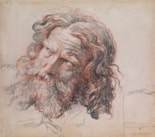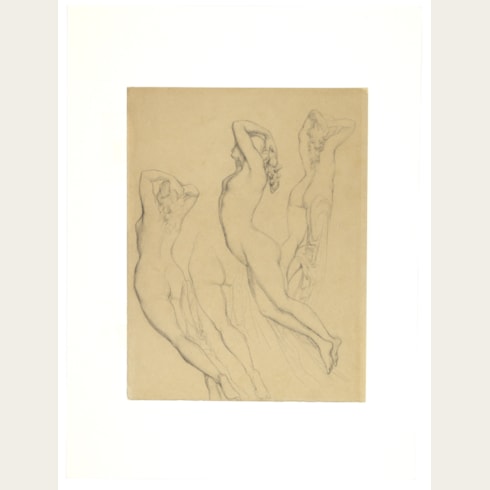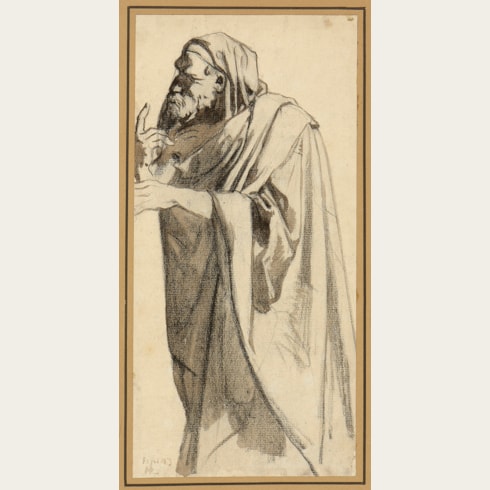Henri LEHMANN
(Kiel 1814 - Paris 1882)
Study of the Head of a Bearded Man
Sold
Black and red chalk.
Dated 17 avril in pencil at the lower centre.
Stamped with studio stamp H. LEHMANN (not in Lugt) at the lower right.
115 x 131 mm. (4 1/2 x 5 1/8 in.)
Dated 17 avril in pencil at the lower centre.
Stamped with studio stamp H. LEHMANN (not in Lugt) at the lower right.
115 x 131 mm. (4 1/2 x 5 1/8 in.)
This is a study for the head of a kneeling figure of Widukind, the Germanic leader of the Saxons, near the centre of Henri Lehmann’s vast hemicycle painting of France under the Reign of the Merovingians and Carolingians is Reborn in Faith and Independence, painted between 1854 and 1856 for the domed ceiling of the throne room of the Palais du Luxembourg in Paris. In the painting, the pagan Saxon chieftain Widukind – Charlemagne’s main opponent during the wars between the Franks and the Saxons of the 8th century - is depicted to the right of the central cross, kneeling before a Frankish priest and being baptized into the Christian faith.
The present sheet was once one of four separate drawings in red and black chalk by Lehmann – all studies for the figure of Widukind - pasted onto a single backing sheet; the other three drawings included two nude studies of the kneeling figure on one sheet and two separate studies of his arms. A preparatory drawing in black chalk for the standing priest who baptizes Widukind is in the Musée Saint-Croix in Poitiers.
An oil sketch modellofor the entire hemicycle composition is in the Musée Carnavalet in Paris.
The present sheet was once one of four separate drawings in red and black chalk by Lehmann – all studies for the figure of Widukind - pasted onto a single backing sheet; the other three drawings included two nude studies of the kneeling figure on one sheet and two separate studies of his arms. A preparatory drawing in black chalk for the standing priest who baptizes Widukind is in the Musée Saint-Croix in Poitiers.
An oil sketch modellofor the entire hemicycle composition is in the Musée Carnavalet in Paris.
Born in the German Duchy of Holstein, Henri Lehmann first studied with his father Leo, a portrait painter and miniaturist. In 1831 he settled in Paris, where the following year he entered the studio of Jean-Auguste Dominique Ingres. He soon became one the master’s favourite pupils and assistants, alongside the brothers Paul and Hippolyte Flandrin. At his Salon debut in 1835 Lehmann won a second-class medal with a painting of Tobias and the Angel, the first of several honours and prizes he was to earn throughout his career. Although he was not permitted to compete for the Prix de Rome, by virtue of his German citizenship, he nevertheless travelled at his own expense to Rome in 1838, rejoining his master Ingres, who had been appointed director of the Académie de France three years earlier. Lehmann lived in Rome until 1842, often assisting Ingres in his studio.
On his return to France Lehmann earned a commission for mural paintings for the Parisian church of Saint-Merri, completed in 1844. Other commissions soon followed, and he began to establish a reputation as a painter of historical and religious subjects, portraits and genre scenes. He became a naturalized French citizen in 1847. During the Second Empire Lehmann painted a number of significant public decorative schemes, notably a series of more than fifty allegorical paintings for the Galerie des Fêtes of the Hôtel de Ville in Paris, completed in 1852 but destroyed by fire during the Commune of 1871, as well as works for the Palais de Luxembourg in the 1850s and the Palais de Justice in the 1860s. Like many of Ingres’ pupils, Lehmann was also in great demand as a fashionable portrait painter. Appointed a professor at the École des Beaux-Arts in 1875, he devoted much of the last years of his career to teaching; among his students was the young Georges Seurat. A large group of drawings by Lehmann is today in the Musée Bonnat in Bayonne.
Provenance
Galerie de Bayser, Paris, in 1982
Galerie Laura Pecheur, Paris
Private collection, Paris
Anonymous sale, Paris, Hôtel Drouot, 25 October 2017, lot 15.
Galerie Laura Pecheur, Paris
Private collection, Paris
Anonymous sale, Paris, Hôtel Drouot, 25 October 2017, lot 15.
Literature
Marie-Madeleine Aubrun, Henri Lehmann 1814-1882: Portraits et décors parisiens, exhibition catalogue, Paris, Musée Carnavalet, 1983, p.125, under no.240; Marie-Madeleine Aubrun, Henri Lehmann 1814-1882: catalogue raisonné de l’oeuvre, Nantes, 1984, Vol.I, p.227, no.D.948A, Vol.II, p.216, fig.D.948A.
Exhibition
Paris, Galerie de Bayser, Henri Lehmann 1814-1882, 1983, no.70.






